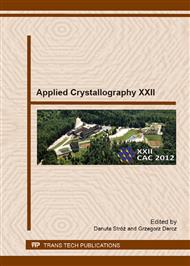p.121
p.125
p.129
p.133
p.137
p.142
p.146
p.150
p.156
Study of Fe75Al25 Alloys by the Mössbauer Spectroscopy Positron Annihilation Lifetime Spectroscopy (PALS), XRD and SEM
Abstract:
The structure, point defect and ordering parameter of Fe25Al samples is examined with the Mössbauer spectroscopy Positron Annihilation Lifetime Spectroscopy XRD and SEM. The studies are carried out for samples in as-cast state and after heat treatments: annealing for 24 hours at 900°C (or 1050°C) and either slow cooling with furnace or quenching to oil. Among the research method used, Mössbauer spectroscopy for determination of hyperfine structure parameters was adopted. These parameters, sensitive to changes in spin and charge electron densities in the nearest neighbourhood of a Mössbauer isotope nucleus, caused by specific configurations of atoms, are directly connected with the degree of ordering of a compound. Spectral analysis has been carried out using an authors’ software developed based on a theoretical model relating the shape of a Mössbauer spectrum to the sample microstructure. It has been shown that Mössbauer spectroscopy enables quantitative evaluation of the degree of ordering of phases occurring in samples characterised by large graining, in the case of which it is not possible to determine the long-range order parameter by X-ray diffraction. The PALS method only one type of defects is detected. The positron lifetime in these defects (V) suggests that they are quenched-in Fe-monovacancies (VFe). The vacancy concentration strongly depends on the rate of cooling.
Info:
Periodical:
Pages:
137-141
Citation:
Online since:
June 2013
Keywords:
Price:
Сopyright:
© 2013 Trans Tech Publications Ltd. All Rights Reserved
Share:
Citation:


